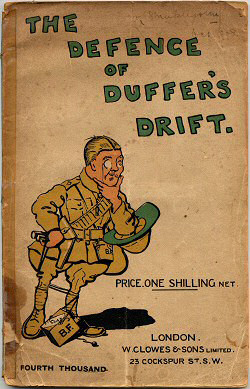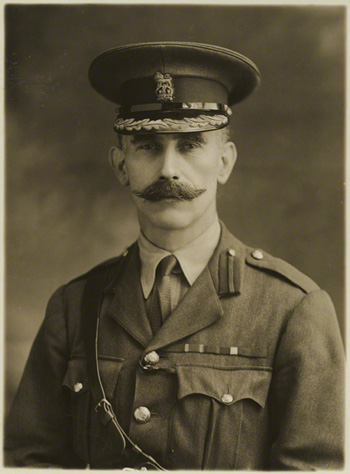Online Book - "The Defence of Duffer's Drift"
The Defence of Duffer's Drift is a short 1904 book by Major General Sir Ernest Dunlop Swinton. It purports to be a series of six dreams by "Lieutenant Backsight Forethought" about the defence of a river crossing in the Boer War. The infantry tactics in the early dreams are disastrous, but each time BF learns something until in the final defence he is successful.

Originally published in the U.S. Infantry Journal, now Army, April 1905.
Introduction
A classic in small unit tactics in the British and U.S. Army, this book is recommended, without qualification, for the modern professional soldier.
What would you do?
Lieutenant Backsight Forethought (BF to his friends) has been left in command of a 50-man reinforced platoon to hold Duffer’s Drift, the only ford on the Silliassvogel River available to wheeled traffic. Here is his chance for fame and glory. He has passed his officer courses and special qualifications.
“Now if they had given me a job like fighting the Battle of Waterloo…or Bull Run, I knew all about that, as I had crammed it up....”
While BF’s task appears simple enough, the Boer enemy causes a multitude of problems, but you, astute reader, with a sharp mind and quick intellect, will no doubt, solve the problem before the first shot is fired.
About the Author
Major General Sir Earnest D. Swinton, K.B.E., C.B., D.S.O., was a noted English soldier, author and professor. Considered by Field Marshal Earl Wavell as one of the most far-sighted officers the British Army has produced, he wrote before World War I on the effects of air warfare, mining and of psychological warfare. In 1914, Sir Swinton completely revolutionized warfare by his invention of the tank; he, more than anyone else, was responsible for its introduction and development.

Major General Sir Earnest D. Swinton
He served as Professor of Military History at Oxford from 1925 to 1939, and later as Commandant of the Royal Tank Corps from 1934 to 1938 - earning the rank of Major General.
As a Captain, shortly after service in the Boer War, he wrote The Defence of Duffer’s Drift, using the pseudonym, Lieutenant Backsight Forethought, or BF. Duffer’s Drift has become a military classic on minor tactics in this century. In addition to Duffer’s Drift, and contributing to many journals, he authored The Green Curve in 1909 and The Great Tab Dope in 1915, under the pseudonym O’le Luk-Oie (Olaf shut-eye). His other works include The Study Of War in 1926 and his final publication, An Eastern Odyssey written in 1935.
Background on The Boer War 1899-1902
The Boers, Dutch for farmer, first settled what is now Cape Province, Republic of South Africa in 1652. After Great Britain annexed this territory in 1806, many of the Boers departed on the “Great Trek” and created the Republic of Natal, the Orange Free State, and the Transvaal. Gradual commercial control by the British and discovery of gold and diamonds, among other things, served to create hostility between the Boers and British, resulting in the South African War or Boer War from 1899 to 1902.
The Boers initially outnumbered the British and were well equipped, scoring impressive victories in the areas adjacent to their territories. Even though the Boer armies finally surrendered, apparent victory for the British was retarded by extensive and coordinated guerilla warfare. The war was finally ended by the systematic destruction of the Boer guerrilla units and hostilities were terminated by the Treaty of Vereeniging in May 1902. The Boer territories were annexed by Great Britain and were organized into the Union of South Africa eight years later.
Back in Afghanistan Hot Spot, U.S. Marines Chase Diminished Goals
Back in Afghanistan Hot Spot, U.S. Marines Chase Diminished Goals by Mujib Mashal - New York Times
The last time American Marines were in Helmand Province, they had a sweeping mission and the resources to carry it out.
Tens of thousands of Marines flooded the southern villages here, and they had tens of millions of dollars in cash to throw into projects that would bolster local support. They spearheaded some of the bloodiest battles of this long war, losing 349 dead in the process, but they succeeded in turning much of what had been prime Taliban and opium territory over to the Afghan government.
Then, following the Obama administration’s deadline to have combat forces out of Afghanistan by the end of 2014, they went home.
Now they are back in Helmand with a changed mission, looking at an overwhelmingly changed map.
Within two years, Helmand, Afganistan’s largest province, all but returned to the hands of the Taliban. Lashkar Gah, the provincial capital and a haven for tens of thousands of refugees from the fighting, has been surrounded for more than a year, and in that time has been infiltrated by insurgents at least three times. The performance of the Afghan forces, left on their own, was catastrophic, with 60 to 70 soldiers dying each week…
U.S. Forces Kill Head of Islamic State’s Afghanistan Operations
U.S. Forces Kill Head of Islamic State’s Afghanistan Operations by Gordon Lubold - Wall Street Journal
U.S. forces in Afghanistan killed the head of Islamic State’s branch in the country earlier this week, the Pentagon said Friday.
American forces killed Abu Sayed, considered the emir of the group that runs the terror network’s operations in Afghanistan, on July 11 in Kunar province, chief Pentagon spokeswoman Dana White said in a statement. The Pentagon provided no additional details on the operation.
Other members of the group, known as ISIS-K, were also killed, which will “significantly disrupt the terror group’s plans to expand its presence in Afghanistan,” Ms. White said in the statement.
The death of Sayed is largely symbolic, since ISIS-K replaces its leaders as soon as they are killed. Sayed is the third such leader in a year, after the previous emir, Abdul Hasib was killed in April by U.S. forces. The emir who held the position before him was Hafiz Sayed Khan, killed by U.S. forces in July 2016.
“Afghan and U.S. forces launched a counter-ISIS-K offensive in early March 2017 to drive fighters from Nangarhar and send a clear message to ISIS that there is no sanctuary for their fighters in Afghanistan,” Ms. White said.
The U.S. has been officially fighting Islamic State in Afghanistan since January 2016, after the group began to establish a presence, mostly in Nangarhar province in eastern Afghanistan. Then-President Barack Obama provided the authority to the Pentagon to begin fighting the group at the time, when there were as many as 3,000 Islamic State fighters there.
That authority has helped curb the group’s activities and now officials estimate the group has fewer than 1,000 fighters inside Afghanistan, according to U.S. officials…
